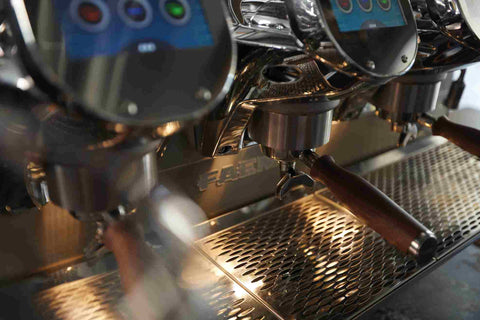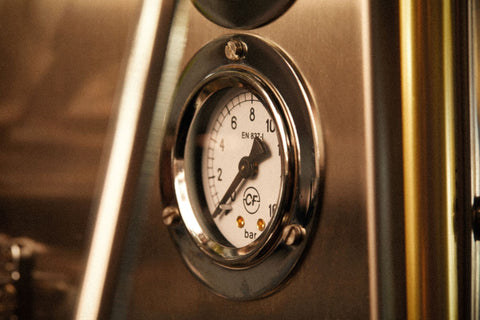Espresso is the fastest growing category in the food and beverage industry from both a profit and a consumption standpoint. The rise in popularity of specialty coffee drinks, such as lattes or cappuccinos, has given way to new generations of coffee connoisseurs and baristas with a keen understanding and taste for espresso-based beverages.
Whether you have just bought a coffee van to serve a few people at the weekend, or whether you have an established cafe already and you’re looking to upgrade your machine to a larger capacity or higher quality of espresso, there is most definitely a commercial espresso machine out there for you.
This guide is created to take some of the guesswork out of your commercial espresso machine buying process. We will list down some important factors to consider and hopefully leave you feeling empowered to make the right choice.
How Do Commercial Espresso Machines Work?

All espresso machines - for home or commercial use - follow a standard workflow. Water is pumped into the espresso machine either from a connected water source or a water tank. The water will then hit the boilers. Most professional coffee machines will have two boilers, one for espresso and one for the steam wand.
Water is heated through the element at a controlled rate that is managed in some machines by a proportional integral derivative (PID). This ensures the water is always at the optimal temperature. The portafilter is locked in place with the tamped puck of espresso.
Water heated to the optimum temperature (around 91C - 95C) is then pumped through the showerhead at 9 bars of pressure onto the bed of coffee and subsequently extracting the perfect espresso that we all know and love.
Factors to Consider When Buying a Commercial Espresso Machine
Making espresso requires the right amount of pressure. That’s why you have to know the number of boilers that your prospective espresso machine has for stable pressure. Go for at least two boilers for consistent pressure, especially in peak periods when the influx of customers is high.
Here are the other features you need to look for in a good-quality commercial espresso machine:
Commercial Espresso Machine Types

There are virtually no labor costs or barista training needed A barista has complete control when using a traditional/semiautomatic type because the machine simply pumps the water. The barista decides everything else: the water to bean ratio; the temperature; tamping the grounds; timing the pull; and turning the machine on and off. Giving a barista full control of their art is the number one method for crafting a magical shot of espresso.
Commercial automatic espresso machines are the perfect balance between control and convenience.The machine controls the extraction time and automates the steam by controlling the amount of water and the time the water pulls. The barista, however, gets to set up the shot which includes steps like choosing the beans and milk, tamping the grounds or using a pod, and locking it into place.
There are virtually no labor costs or barista training needed with a super automatic commercial expresso machine. At the push of a button, super automatics enable you to serve up cappuccinos, lattes, macchiatos, and several other popular espresso-based beverages in your restaurant or café.
The number of Group Heads
How many group heads would you ideally like? There are professional espresso machines with up to 5 and sometimes six group heads. The vast majority, however, are either 1, 2 or 3 groups. Prevent backorders by investing in an espresso machine with at least two group heads. You’ll need a large space for it and more time to clean, but it’s all worth it if it would mean happy and satisfied customers.
Recovery Time

Recovery time is the time between pulls, whether that is pulling an espresso shot or steaming a latte. The best commercial machines will have no recovery time and should be able to pull or texturize a second shot without delay.
Double Boiling vs. Thermocycling
A double boiler system uses two boilers: one to heat up water and one to steam milk. Double boiler systems require recovery time between pulls. The most efficient commercial espresso machines today use thermocycling in place of double boilers.
Thermocycling works by heating a heavy group head to a specific temperature which forces the water to maintain that temperature consistently while the machine is in use. Thermocycling brewing systems have a number of advantages over double boiler systems including:
- Absolute temperature consistency throughout the brew cycle.
- Thermocycling is more cost effective.
- Thermocycling requires no recovery time.
- Fewer repairs
Water Management Features
Water may have excessive chloride content or low pH that can cause corrosion of stainless boilers. That’s why you might need to install a carbon block or reverse-osmosis system. Check with your seller if the espresso machine possesses water management features.
Power

Every espresso machine differs in input voltage. The warranty terms usually require an electrician to ensure that your voltage matches with the espresso machine. You might need a boost transformer. It’s used to bring the voltage as close as possible to the machine’s specification sheet. Add a surge suppressor to protect your breaker panel against lightning strikes.
Commercial Espresso Machines at Faema Montreal
When it comes to choosing the right espresso machine for your business, you have to decipher the type, features, and quality that you prefer. Get help making the right choice by visiting Faema Montreal and browse the selection of all the commercial espresso machines available in store or online. We have been experts in everything espresso since 1968. With brands like Faema, Rocket, La Pavoni, Isomac, Casadio and much more, you will surely find just the right commercial espresso machines you need for your business.






